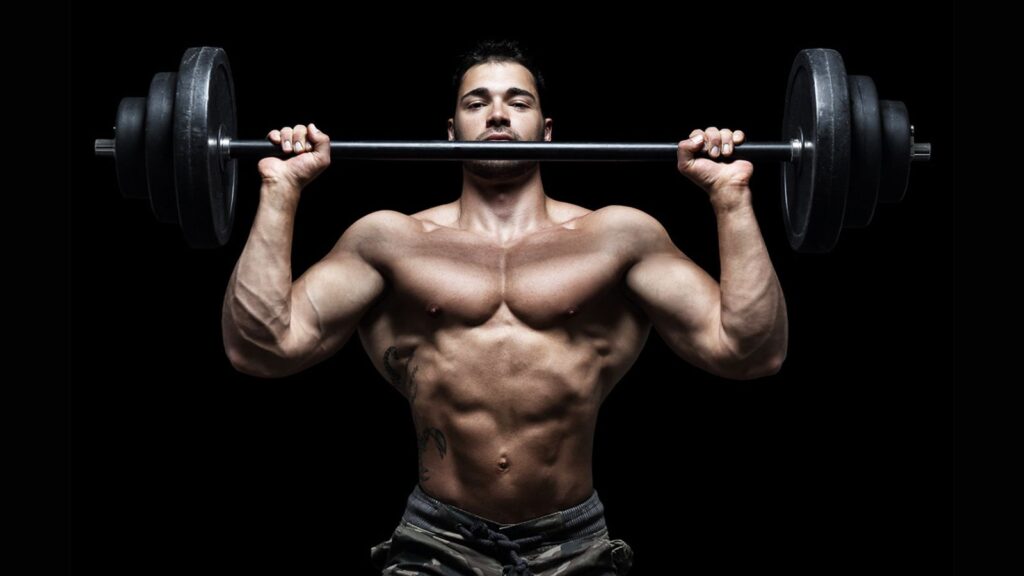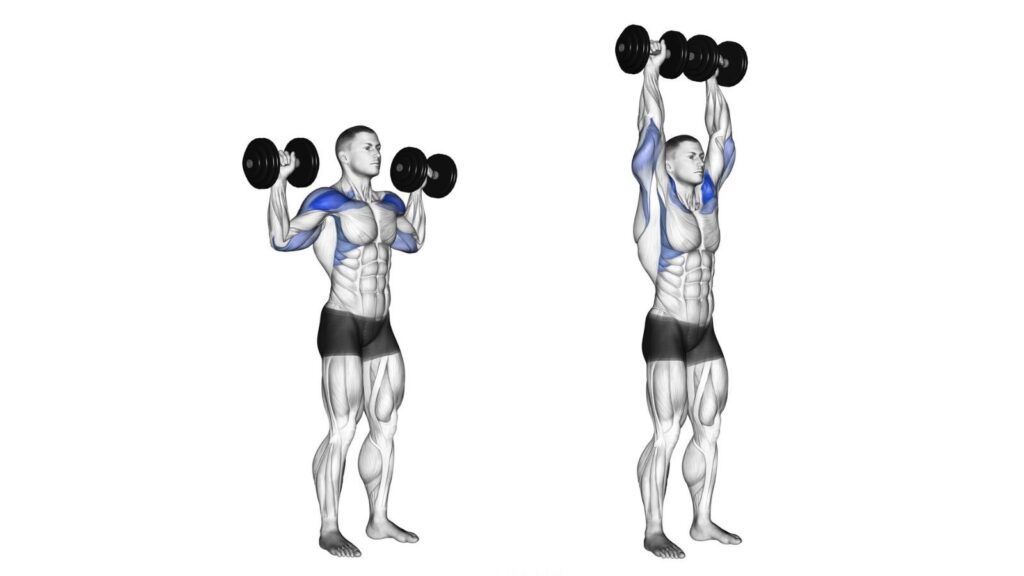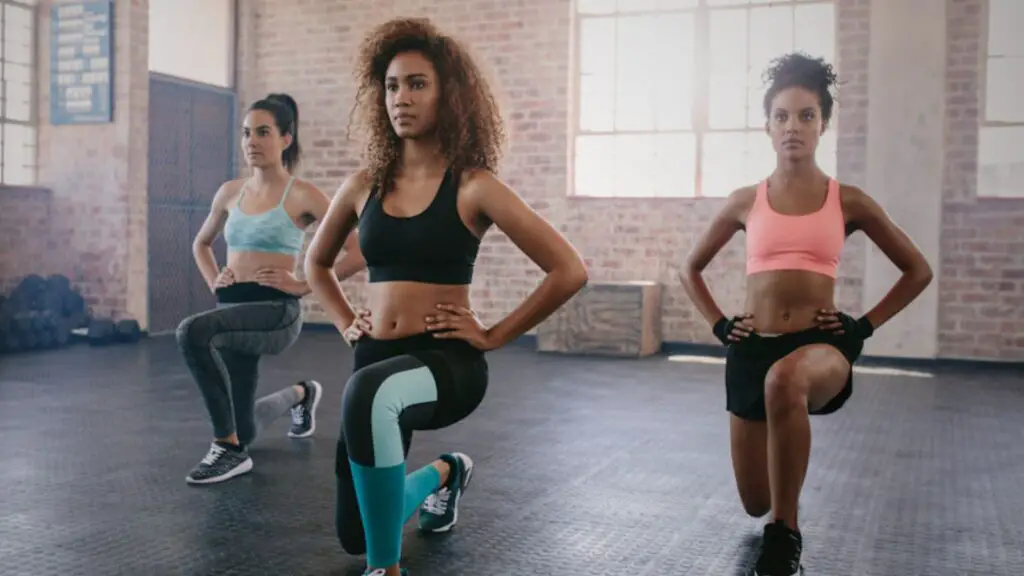You’re ready to start working on your shoulders, but you don’t know which exercise is more effective? Or, maybe you’ve been doing the shoulder press for a while and want to try something different to target that area.
Arnold Press can be a great exercise for your shoulders, rotating your arms as you lift the dumbbells overhead. After all how can an exercise made by the legendary Arnold Schwarzenegger not be an effective way to train.
In this article we compare the traditional Shoulder Press vs Arnold Press, giving you a better understanding of how and when to use either one.
What are the similarities?
Shoulder press and Arnold press are both popular shoulder-strengthening exercises used in weight training. While they have some differences in terms of form and execution, they also share several similarities:
- Muscle Targeting: Both exercises primarily target the deltoid muscles in the shoulders. The front deltoid is heavily involved in both exercises, while the lateral and posterior deltoid muscles are also engaged to varying degrees.
- Compound Movements: Shoulder press and Arnold press are compound exercises, meaning they involve multiple joints and muscle groups. They not only work the shoulders but also engage the triceps and upper chest to some extent.
- Use of Weights: Each exercise typically involve the use of dumbbells or barbells to add resistance and challenge the shoulder muscles. This helps to increase strength and muscle development.
- Range of Motion: The shoulder joint moves through a full range of motion in both the shoulder press and Arnold press. This can help improve shoulder mobility and flexibility.
- Core Stabilization: To perform both exercises effectively, you need to engage your core muscles to stabilize your torso and maintain proper posture throughout the movement.
- Overhead Pressing: Both exercises involve pressing weights overhead. This motion is a fundamental component of building shoulder strength and stability.
What are the differences?
While shoulder press and Arnold press share some similarities, they do differ in terms of how you actually perform them:
Shoulder Press (Overhead Press)
- In the traditional shoulder press, the palms face forward throughout the movement. This exercise is typically done standing, although seated versions exist, and it primarily targets the anterior deltoid.
- A shoulder press can be performed with either a barbell or dumbbell.
Arnold Press
- In the Arnold press, you perform a seated dumbbell press where the palms start by facing you (inward), resting just in front of your chin. Then you rotate outward as you press the weights overhead.
Both exercises are effective for building shoulder strength and size, but the Arnold press involves a unique twisting motion that can provide a slightly different stimulus to the shoulder muscles compared to the traditional shoulder press.
The choice between the two may depend on your personal preference and your specific fitness goals.
Target muscle
Shoulder press and Arnold press primarily target the shoulder muscles, but they work different parts of the shoulder complex to varying degrees.

Here’s a breakdown of the specific muscles each exercise targets:
Shoulder Press (Overhead Press)
- Front Deltoids (Anterior Deltoids): The shoulder press primarily targets the front deltoids. They are engaged when lifting the weights overhead with the palms facing forward.
- Side Deltoids (Lateral Deltoids): The lateral deltoids are engaged, particularly when the arms are raised to the sides during the pressing phase.
- Triceps Brachii: The triceps, the muscles at the back of the upper arm, play a role in extending the elbow to push the weights overhead.
Arnold Press
- Front Deltoids (Anterior Deltoids): The Arnold press heavily targets the front deltoid muscles, which are responsible for shoulder flexion (raising the arm forward).
- Side Deltoids (Lateral Deltoids): The lateral deltoids are also worked in the Arnold press, especially during the pressing phase. They assist in raising the arms to the sides.
- Rear Deltoids (Posterior Deltoids): The rear deltoids are engaged to some extent, primarily during the lowering phase of the exercise.
- Triceps Brachii: The triceps are involved in the extension of the elbow during the pressing phase of the Arnold press.
While both exercises primarily target the anterior deltoids, the Arnold press engages the front delts slightly differently compared to the shoulder press, which is a more straightforward overhead pressing motion.
To get a well-rounded shoulder workout, it’s often beneficial to include a variety of shoulder exercises that target all aspects of the deltoid muscles, such as the front, side, and rear deltoids.
How to do Shoulder Press?
The shoulder press, also known as the overhead press, is a compound exercise that primarily targets the shoulder muscles.
Here’s how you can perform a shoulder press using a barbell or dumbbells:
Using a Barbell
- Set Up: Start by loading a barbell with an appropriate weight. You can use a squat rack or a dedicated bench press station with a barbell support. Place the barbell at chest height or slightly lower on the rack.
- Positioning: Stand in front of the barbell with your feet hip-width apart. Your chest should be up, and your back should be straight. Grip the barbell slightly wider than shoulder-width, with your palms facing forward.
- Lift the Bar: Lift the bar off the rack by straightening your hips and knees. The bar should be resting on your upper chest with your elbows pointed forward.
- Pressing: Take a deep breath, brace your core, and then push the barbell upward. Extend your arms fully, but do not lock your elbows. Keep your head in a neutral position, and make sure the barbell moves in a straight line.
- Lowering: Lower the barbell under control back to the starting position, just above your upper chest. Avoid letting the barbell crash onto your chest.
- Repetitions: Perform the desired number of repetitions and then carefully re-rack the barbell on the rack.
Using Dumbbells
- Set Up: Sit on a bench with back support and set the bench to a 90-degree angle or use a dedicated adjustable bench. Place a dumbbell in each hand on your thighs.
- Positioning: Sit with your back firmly against the bench, feet flat on the floor, and your core engaged. Hold a dumbbell in each hand with your palms facing forward. The dumbbells should be at shoulder height.
- Pressing: Take a deep breath and press the dumbbells overhead by extending your arms fully. Keep your palms facing forward throughout the movement.
- Lowering: Lower the dumbbells back to the starting position, just above shoulder height. Ensure controlled movement during the descent.
- Repetitions: Perform the desired number of repetitions. When done, carefully place the dumbbells back on your thighs, then stand up and re-rack the dumbbells.
Tips for a successful shoulder press:
- Maintain proper form with a neutral spine and engaged core.
- Keep your elbows slightly in front of the bar or dumbbells to protect your shoulder joints.
- Use a weight that challenges you but allows you to maintain good form.
- Breathe properly, inhaling before the lift and exhaling during the press.
The shoulder press can also be performed while standing, using a Smith machine, or with resistance bands. Always start with a light warm-up set and gradually increase the weight as you become more comfortable with the exercise.
When should you do Shoulder Press?
When to incorporate the shoulder press into your workout routine depends on your overall training program and goals.
Here are some common scenarios for when to include the shoulder press:
Strength Training or Resistance Training Routine:
- You can include the shoulder press in your strength training or resistance training routine, whether you’re following a full-body workout plan or a specific upper-body workout.
- It’s a compound movement that works well with other upper-body exercises like bench presses, rows, and pull-ups.
Dedicated Shoulder Workout:
- If you want to prioritize shoulder development, you can have a dedicated shoulder workout session where you perform various shoulder exercises, including the shoulder press.
- This can be especially useful if you’re aiming to build broader shoulders.
Push Day:
- Some people incorporate the shoulder press on their push day, which focuses on exercises that involve pushing movements.
- This can include exercises like bench presses and triceps dips in addition to the shoulder press.
Upper-Body Split:
- If you’re following an upper-body split routine, you might include the shoulder press on a specific day when you target your upper body.
- This allows you to focus on the chest, back, and shoulders during that workout.
End of Workout:
- Some individuals prefer to perform shoulder exercises, including the shoulder press, at the end of their workout.
- This is often done to prevent fatigue that might hinder performance in other exercises, like bench pressing.
Functional Training:
- If your goal is functional fitness, the shoulder press is a valuable exercise for developing upper body strength and stability.
- Incorporate it into your training to enhance your ability to push objects overhead.
Specific Training Goals:
- Adjust when you do the shoulder press based on your specific goals. For instance, if you’re training for a strength competition, you might focus on heavy shoulder pressing.
- If you’re working on muscular endurance, lighter weights with higher repetitions could be part of your routine.
Remember to include a warm-up to prepare your shoulders and prevent injury, and tailor your routine to your fitness level and goals.
Benefits of Shoulder Press
The shoulder press, also known as the overhead press, is a fundamental strength-training exercise that offers a wide range of benefits, primarily targeting the shoulder muscles.

Here are some of the key benefits of including the shoulder press in your workout routine:
- Strengthening the Shoulder Muscles: The primary benefit of the shoulder press is the development and strengthening of the shoulder muscles, including the deltoids.
- Functional Upper Body Strength: Shoulder press engages multiple muscle groups, helping improve overall upper body strength and stability, making daily tasks and activities easier.
- Improved Posture: Strengthening the shoulder and upper back muscles through the shoulder press can contribute to better posture by helping to counteract the effects of slouching and rounded shoulders.
- Enhanced Core Engagement: Maintaining proper form during the shoulder press requires strong core engagement. This exercise can help develop core strength and stability.
- Increased Bone Density: Weight-bearing exercises like the shoulder press promote bone health and density, reducing the risk of osteoporosis.
- Enhanced Upper Body Aesthetics: Regularly incorporating the shoulder press into your workout routine can contribute to a more balanced and aesthetically pleasing upper body, creating a V-taper appearance.
- Better Athletic Performance: Strong shoulders and upper body muscles are essential for various sports and activities, including weightlifting, powerlifting, and throwing sports.
- Full-Body Stabilization: The shoulder press requires the use of various stabilizer muscles, making it a functional exercise for enhancing overall body stability and control.
- Improved Overhead Lifting Abilities: The shoulder press can translate into better performance in other exercises or activities that involve lifting objects overhead.
- Progressive Overload: As you get stronger, you can progressively increase the weight you lift during shoulder presses, promoting muscle growth and continued strength development.
- Mental Focus: Performing heavy shoulder presses requires focus and mental strength, which can help improve your overall mental discipline.
- Versatility: The shoulder press can be performed with various equipment, including barbells, dumbbells, kettlebells, and resistance bands, making it adaptable to different fitness levels and settings.
It’s important to note that while the shoulder press offers numerous benefits, it should be performed with proper form to prevent injury.
Cons of Shoulder Press
While the shoulder press offers several benefits, it also has its share of potential drawbacks and cons, especially if performed improperly or if certain precautions are not taken. Here are some of the potential disadvantages and considerations associated with the shoulder press:
- Risk of Shoulder Injury: The shoulder press places a significant load on the shoulder joints, and improper form, excessive weight, or overuse can lead to shoulder injuries.
- Neck and Spinal Strain: Poor form during the exercise can lead to neck and spinal strain, especially if you use excessive weights or hyperextend your neck to get the barbell or dumbbells overhead.
- Difficulty for Beginners: The shoulder press can be challenging for beginners, and it may take some time to develop the necessary strength and coordination to perform the exercise effectively and safely.
- Lack of Access to Equipment: Access to barbells and a squat rack or dedicated bench press station may be limited in some gyms or home setups, which can make it challenging to perform the shoulder press.
- Muscle Imbalances: Focusing excessively on the front deltoids without balancing with exercises for the rear deltoids and other shoulder muscles can lead to muscle imbalances and increased risk of injury.
- Overuse Injuries: Overtraining or performing the shoulder press too frequently without sufficient recovery can lead to overuse injuries in the shoulder, such as tendinitis.
- Not Suitable for Everyone: Individuals with certain pre-existing shoulder issues or mobility limitations may not be able to perform the shoulder press safely, and it may exacerbate their condition.
- Inadequate Warm-Up: Failing to warm up properly before the shoulder press can increase the risk of injury. It’s essential to prepare the shoulder joints and muscles with dynamic stretches and warm-up exercises.
- Ineffective Form: Performing the shoulder press with poor form, such as excessive arching of the lower back, can strain the lower back and lead to discomfort or injury.
- Limited Range of Motion: Some individuals may have limited shoulder mobility, making it challenging to perform the shoulder press with a full range of motion, reducing exercise effectiveness while increasing the risk of injury.
It’s crucial to use proper form, progressively increase the weight as your strength improves, include a balanced shoulder workout routine, and ensure you warm up adequately.
If you have any pre-existing shoulder issues or doubts about the exercise’s safety for you, it’s a good idea to consult with a healthcare professional or a qualified fitness trainer for guidance and recommendations.
How to do Arnold Press?
The Arnold press, also known as the Arnold dumbbell press, is a shoulder exercise that incorporates a rotational movement. It mainly targets the front and side deltoid muscles.
Here’s how to perform the Arnold press:
Using Dumbbells:
- Set Up: Start by selecting a pair of dumbbells that you can comfortably lift for your desired number of repetitions. Sit on a bench with back support that has a vertical backrest or use a chair with back support.
- Positioning: Sit with your back against the support and your feet flat on the floor. Hold a dumbbell in each hand, with your palms facing you (thumbs pointing toward your shoulders) and your elbows bent at a 90-degree angle. This is your starting position.
- Pressing Motion: a. As you exhale, press the dumbbells upward, extending your arms fully. Simultaneously, rotate your wrists outward, so your palms face forward at the top of the movement. This rotational movement is unique to the Arnold press. b. Continue to press the dumbbells overhead until your arms are almost fully extended, but do not lock your elbows.
- Lowering Motion: Inhale and reverse the movement by lowering the dumbbells back to the starting position. During this descent, rotate your wrists back to the original position with your palms facing you.
- Repetitions: Perform the desired number of repetitions while maintaining proper form.
Tips for a successful Arnold press:
- Start with a light weight to get comfortable with the rotational movement before increasing the load.
- Keep your core engaged and your back flat against the bench or chair for stability.
- Control the weights throughout the entire range of motion, especially during the rotational phase.
- Breathe in a controlled manner, exhaling during the pressing phase and inhaling during the lowering phase.
- Maintain a smooth and controlled pace throughout the exercise.
The Arnold press can help target both the front and side deltoid muscles while also enhancing shoulder mobility.
When should you do Arnold Press?
When to do the Arnold press depends on your overall training program, goals, and preferences. It’s a versatile exercise that can be incorporated into your shoulder or upper-body workout routine.
Here are some common scenarios for incorporating the Arnold press into your workout routine:
Shoulder Workout:
- The Arnold press can be a valuable addition to your shoulder workout. You can include it along with other shoulder exercises like lateral raises, front raises, and upright rows.
- It targets both the front and side deltoid muscles, providing a comprehensive shoulder workout.
Upper Body or Push Day:
- You can include the Arnold press on upper body or push-focused workout days.
- This is especially beneficial if you’re following a split routine where you target different muscle groups on different days.
Variation in Shoulder Routine:
- To add variety to your shoulder routine and prevent workout plateaus, consider using the Arnold press as an alternative to traditional shoulder press exercises.
- This prevents boredom and keeps the workout interesting
Muscle Imbalance Correction:
- If you want to address muscle imbalances within the shoulder complex, the Arnold press can help target the side deltoids, which are sometimes underemphasized in standard shoulder workouts.
Functional Training:
- Incorporate the Arnold press into functional training routines to improve shoulder mobility and stability, which can be beneficial for daily activities and sports.
Warm-Up:
- You can use the Arnold press as part of your warm-up to improve shoulder joint mobility and strengthen the rotator cuff muscles.
- This is great for reducing the risk of injury.
Periodic Variation:
- For variety and to prevent exercise boredom, periodically switch between different shoulder exercises, including the Arnold press, to keep your workouts fresh and engaging.
Progressive Overload:
- As you become more proficient at the Arnold press, you can increase the weight to progressively challenge your shoulder muscles and promote growth.
Rehabilitation:
- Some individuals use the Arnold press as part of their rehabilitation routine to address shoulder issues or improve shoulder health.
When including the Arnold press in your routine, it’s important to prioritize proper form and exercise technique.
Benefits of Arnold Press
The Arnold press offers a range of benefits, making it a valuable addition to your workout routine.

Here are some of the benefits of performing the Arnold press:
- Improved Shoulder Strength: Regularly incorporating the Arnold press into your routine helps increase shoulder strength, which is crucial for various daily activities and sports.
- Enhanced Shoulder Mobility: The rotational movement involved in the Arnold press promotes improved shoulder joint mobility. It can be particularly helpful for individuals looking to enhance their shoulder flexibility and range of motion.
- Muscle Balance: The exercise helps maintain muscle balance within the shoulder complex by targeting both the front and side deltoids. This can be beneficial for reducing the risk of muscle imbalances that can lead to injury.
- Functional Fitness: The Arnold press is a functional exercise that mimics movements you might perform in daily life, such as reaching and lifting objects overhead, helping improve your functional fitness.
- Stabilization Training: The exercise requires core stabilization to maintain proper form. This helps improve core strength and stability, which is essential for various activities and sports.
- Variety in Workouts: Adding the Arnold press to your routine adds variety to your shoulder workouts. Switching up exercises can prevent plateaus and keep your workouts interesting.
- Mental Focus: The Arnold press demands concentration and coordination, making it a great exercise for enhancing mental focus during your workouts.
- Strengthens Rotator Cuff Muscles: The rotational component of the Arnold press can help strengthen the rotator cuff muscles, which are important for shoulder stability and injury prevention.
- Progressive Overload: As you become more proficient at the Arnold press, you can progressively increase the weight, which is crucial for muscle growth and strength development.
- Shoulder Aesthetics: Consistent Arnold press training can contribute to broader and more defined shoulders, enhancing your overall shoulder aesthetics.
To fully enjoy these benefits and minimize the risk of injury, it’s important to use proper form, with a weight that allows for controlled movement.
Cons of Arnold Press
While the Arnold press offers various benefits for shoulder development and mobility, it also has some potential drawbacks and considerations to be aware of:
- Complex Technique: The Arnold press involves a unique rotational movement of the shoulders. This added complexity can make it challenging for beginners to maintain proper form, leading to injury.
- Risk of Shoulder Strain: The rotational aspect of the Arnold press can place extra stress on the shoulder joint, potentially increasing the risk of strain or injury, especially when performed with heavy weights or poor form.
- Neck Strain: If not executed correctly, the Arnold press may lead to neck strain, especially if you hyperextend your neck to clear the dumbbells during the movement.
- Limited Weight: Some individuals may find that they can lift less weight with the Arnold press compared to other shoulder exercises like the standard shoulder press. This can be a disadvantage if your goal is to lift heavy weights for strength gains.
- Initial Discomfort: Beginners may experience discomfort or confusion when attempting the unique rotational movement in the Arnold press.
- Not Suitable for Everyone: Individuals with pre-existing shoulder issues, such as impingements, instability, or mobility limitations, may not be able to perform the Arnold press safely.
- Potential for Overuse Injuries: Like any exercise, overdoing the Arnold press or performing it too frequently without adequate rest and recovery can lead to overuse injuries, especially in the shoulder area.
- Limited Equipment Access: Not all gyms have the necessary equipment or benches for performing the Arnold press, which may limit your ability to include it in your workout routine.
To mitigate these potential cons, beginners may benefit from working with a fitness professional to learn and master the correct form.

Additionally, individuals with existing shoulder concerns should consult with a healthcare professional or physical therapist before incorporating the Arnold press into their workout routine.
If you experience discomfort or pain while performing the exercise, it’s essential to stop and seek guidance.
FAQs
Can you do both shoulder press and Arnold press?
Yes, it’s actually even better if you include both exercises within your workout routine.
By incorporating both the shoulder press and Arnold press into your training routine, you can develop your strength while improving your shoulder mobility.
You’ll also have bigger gains and progress quicker in your muscle development journey.
Check out our article on Shoulder Press vs Lateral raises, to get an understanding of how to improve your workout to get even better looking shoulders.
Which exercise is better for strength building?
The shoulder press is a perfect choice for those focusing on building maximal shoulder strength. It can be easier to progressively increase the weight lifted over time, because of it’s simple movement.
Which exercise is better for overall aesthetics?
The Arnold press can contribute to a more balanced and visually appealing shoulder appearance, as it targets multiple aspects of the shoulder muscles. This includes both the front deltoids and the side deltoids (lateral deltoids).



